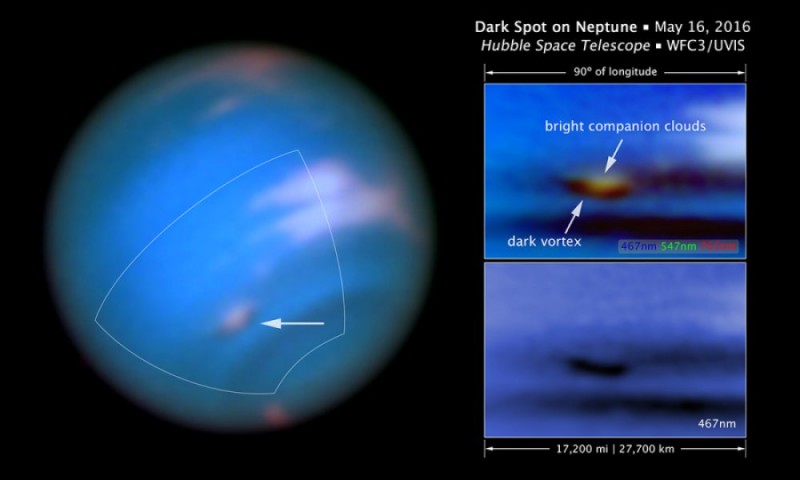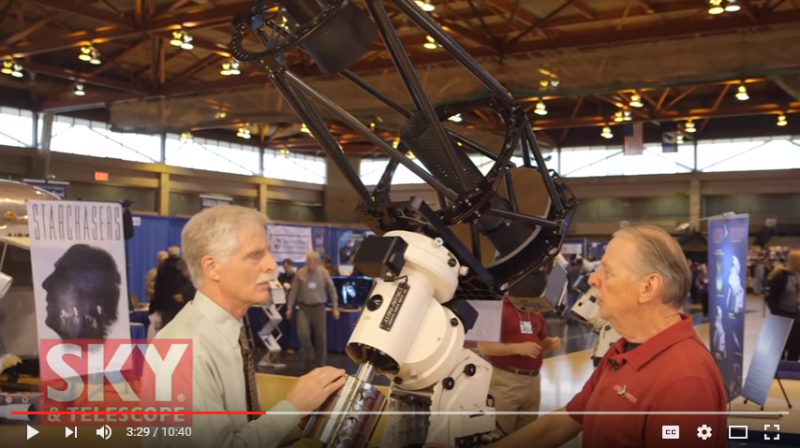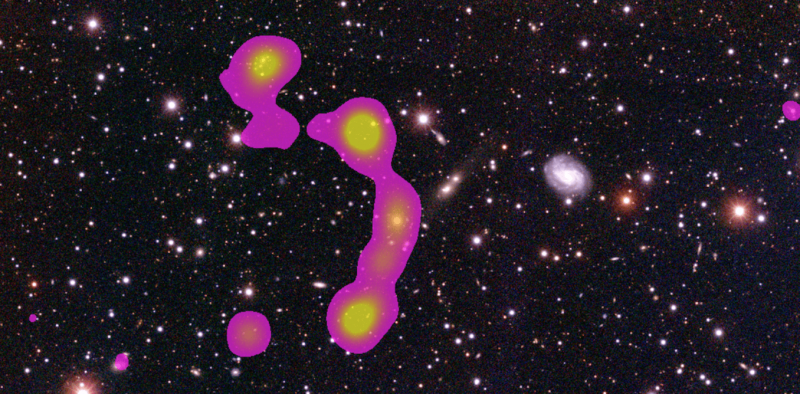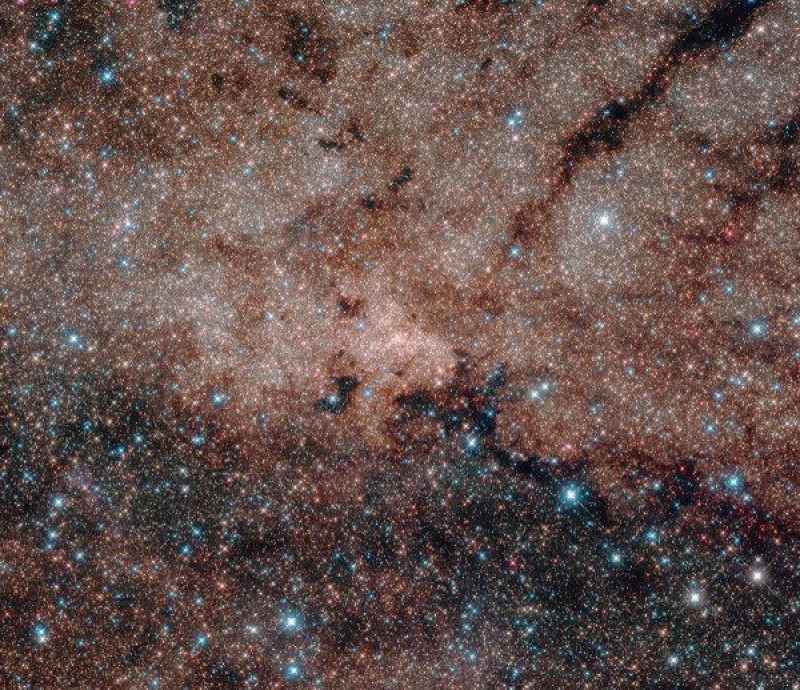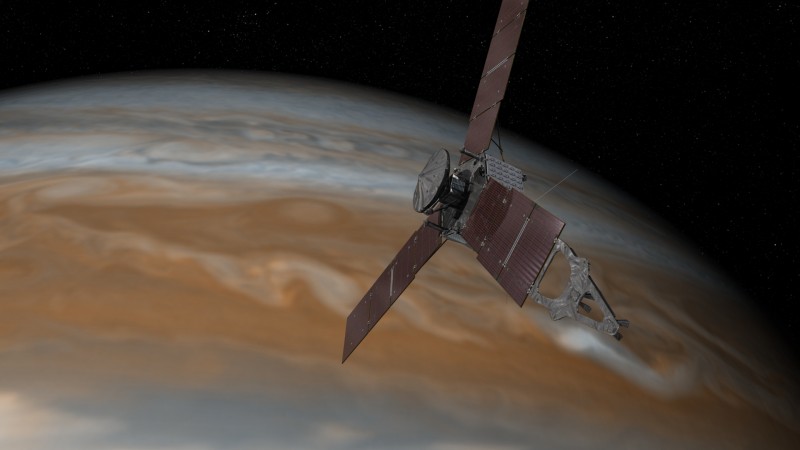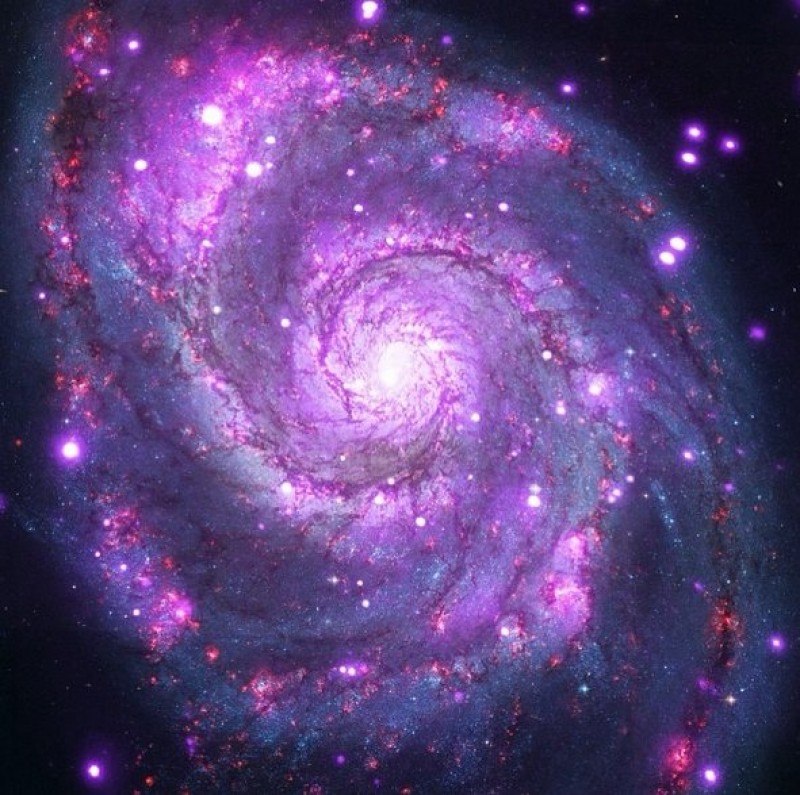Blog
Listen: NASA's Juno Spacecraft Enters Jupiter's Magnetic Field
Saturday, July 2nd 2016 09:54 PM
NASA's Jupiter-bound Juno spacecraft has entered the planet's magnetosphere, where the movement of particles in space is controlled by what's going on inside Jupiter.
"We've just crossed the boundary into Jupiter's home turf," said Juno Principal Investigator Scott Bolton of Southwest Research Institute, San Antonio. "We're closing in fast on the planet itself and already gaining valuable data."
Juno is on course to swing into orbit around Jupiter on July 4. Science instruments on board detected changes in the particles and fields around the spacecraft as it passed from an environment dominated by the interplanetary solar wind into Jupiter's magnetosphere. Data from Juno's Waves investigation, presented as audio stream and color animation, indicate the spacecraft's crossing of the bow shock just outside the magnetosphere on June 24 and the transit into the lower density of the Jovian magnetosphere on June 25.
"The bow shock is analogous to a sonic boom," said William Kurth of the...
Read More
Read More
Hubble Confirms New Dark Spot on Neptune
Saturday, June 25th 2016 10:24 PM
The full visible-light image at left shows that the dark feature resides near and below a patch of bright clouds in the planet's southern hemisphere. The dark spot measures roughly 3,000 miles (4,800 kilometers) across. Other high-altitude clouds can be seen at the planet's equatorial region and polar regions. The full-color image at top right is a close-up of the complex feature. Pancake-shaped clouds above the spot form when ambient air is perturbed and diverted upward over the vortex. The vortex is a high-pressure system. The image at bottom right shows that the vortex is best seen at blue wavelengths. Only Hubble has the high resolution required for identifying such weather features on distant Neptune
New images obtained on May 16, 2016, by NASA's Hubble Space Telescope confirm the presence of a dark vortex in the atmosphere of Neptune. Though similar features were seen during the Voyager 2 flyby of Neptune in 1989 and by the Hubble Space Telescope in 199...
Read More
Read More
Roland Christen Demonstrates the New AP 17in Astrograph on a 1600GTO Mount with New CP4 Control Box
Thursday, June 23rd 2016 09:06 PM
Roland Christen gives Dennis di Cicco an overview of Astro-Physics’s brand new 17-inch astrograph, the largest telescope offered by the renowned manufacturer of refractors, astrographs, and German equatorial mounts. He also explains some of the advanced features added to the company’s new GTOCP 4 control box that retrofits with all of the earlier Astro-Physics mounts having servo-motor drives.
See the Astro-Physics 1600GTO German Equatorial Mount with NEW GTOCP4 Control Box
Read More
Read More
Citizen Scientists Discover Giant Cluster of Galaxies
Saturday, June 18th 2016 12:06 AM
The new discovery: The C-shaped “wide angle tail galaxy” (pink) surrounded by the galaxies of the Matorny-Terentev cluster (white). Credit: Julie Banfield
It used to be that you had to have years of training before you could participate in cutting-edge science.
But that has changed, with the power of the internet enabling thousands of ordinary people to contribute to one of humanity's most exciting endeavours from the comfort of their homes.
It was announced in May that a cluster of galaxies millions of light years away was discovered by a team of citizen scientists clicking on images on their computers at home.
Citizen science
Citizen Science first became prominent in 2006 with the launch of Stardust@home by the University of California-Berkeley, quickly followed in 2007 by Galaxy Zoo, which aimed to classify galaxies from optical images.
Now, many such citizen science projects span all fields of science...
Read More
Read More
New Planet Discovery Is Largest Orbiting Twin Sun
Wednesday, June 15th 2016 12:43 AM
Artist's impression of the simultaneous stellar eclipse and planetary transit events on Kepler-1647.
Credits: Lynette Cook
If you cast your eyes toward the constellation Cygnus, you’ll be looking in the direction of the largest planet yet discovered around a double-star system. It’s too faint to see with the naked eye, but a team led by astronomers from NASA’s Goddard Space Flight Center in Greenbelt, Maryland, and San Diego State University (SDSU) in California, used NASA's Kepler Space Telescope to identify the new planet, Kepler-1647b.
The discovery was announced June 13th, 2016, in San Diego at a meeting of the American Astronomical Society. The research has been accepted for publication in the Astrophysical Journal with Veselin Kostov, a NASA Goddard postdoctoral fellow, as lead author.
Kepler-1647 is 3,700 light-years away and approximately 4.4 billion years old, roughly the same age as Earth. The stars are similar to...
Read More
Read More
Young Star Apparently Tearing Away Layers of Nearby Planet
Thursday, June 9th 2016 11:43 PM
An artist's impression of likely new giant planet PTFO8-8695 b, which is believed to orbit a star in the constellation Orion every 11 hours. Gravity from the newborn star appears to be pulling away the outer layers of the Jupiter-like planet. Credit: . Passwaters/Rice University based on original available under CC license on Wikipedia
Astronomers searching for the galaxy's youngest planets have found compelling evidence for one unlike any other, a newborn "hot Jupiter" whose outer layers are being torn away by the star it orbits every 11 hours.
"A handful of known planets are in similarly small orbits, but because this star is only 2 million years old this is one of the most extreme examples," said Rice University astronomer Christopher Johns-Krull, lead author of a new study that makes a case for a tightly orbiting gas giant around the star PTFO8-8695 in the constellation Orion. The peer-reviewed study will be published in The Astrophysical Jou...
Read More
Read More
Hubble Peers Into Center of Milky Way
Thursday, June 9th 2016 11:06 PM
Hubble's infrared vision pierced the dusty heart of our Milky Way galaxy to reveal more than half a million stars at its core.
Peering deep into the heart of our Milky Way galaxy, NASA's Hubble Space Telescope reveals a rich tapestry of more than half a million stars. Except for a few blue, foreground stars, the stars are part of the Milky Way's nuclear star cluster, the most massive and densest star cluster in our galaxy. So packed with stars, it is equivalent to having a million suns crammed into the volume of space between us and our closest stellar neighbor, Alpha Centauri. At the very hub of our galaxy, this star cluster surrounds the Milky Way's central supermassive black hole, which is about 4 million times the mass of our sun.
Astronomers used Hubble's infrared vision to pierce through the dust in the disk of our galaxy that obscures the star cluster. In this image, scientists translated the infrared light, which is invisible to human eyes, into co...
Read More
Read More
Juno Spacecraft Passes Jupiter/Sun Gravitational Boundary
Saturday, June 4th 2016 10:43 PM
This artist's rendering shows NASA's Juno spacecraft making one of its close passes over Jupiter.
Credits: NASA/JPL-Caltech
Since its launch five years ago, there have been three forces tugging at NASA's Juno spacecraft as it speeds through the solar system. The sun, Earth and Jupiter have all been influential -- a gravitational trifecta of sorts. At times, Earth was close enough to be the frontrunner. More recently, the sun has had the most clout when it comes to Juno's trajectory. Today, it can be reported that Jupiter is now in the gravitational driver’s seat, and the basketball court-sized spacecraft is not looking back.
"Today the gravitational influence of Jupiter is neck and neck with that of the sun," said Rick Nybakken, Juno project manager at NASA's Jet Propulsion Laboratory in Pasadena, California. "As of tomorrow, and for the rest of the mission, we project Jupiter's gravity will dominate as the trajectory-perturbing effects by other c...
Read More
Read More
A New Solution to Measuring the Milky Way
Friday, June 3rd 2016 12:33 AM
It is a galactic challenge, to be sure, but Gwendolyn Eadie is getting closer to an accurate answer to a question that has defined her early career in astrophysics: what is the mass of the Milky Way?
The short answer, so far, is 7 X 1011 solar masses. In terms that are easier to comprehend, that's about the mass of our Sun, multiplied by 700 billion. The Sun, for the record, has a mass of two nonillion (that's 2 followed by 30 zeroes) kilograms, or 330,000 times the mass of Earth.
"And our galaxy isn't even the biggest galaxy," Eadie says.
Measuring the mass of our home galaxy, or any galaxy, is particularly difficult. A galaxy includes not only stars, planets, moons, gases, dust and other objects and material, but also a big helping of dark matter, a mysterious and invisible form of matter that is not yet fully understood and has not been directly detected in the lab. Astronomers and cosmologists, however, can infer the presence of dark matter through its gravitational influence...
Read More
Read More
Luminous Diffuse Gamma-Ray Emission Detected from Arp 220
Wednesday, May 25th 2016 07:49 PM
Griffin and Dai developed the data collection methodology used to detect the gamma-ray emission from Arp 220.
Credit: University of Oklahoma and NASA
A University of Oklahoma team has detected for the first time the most luminous gamma-ray emission from a galaxy--the merging galaxy Arp 220 is the nearest ultraluminous infrared galaxy to Earth, and it reveals the hidden extreme energetic processes in galaxies. The first gamma-ray detection of an ultraluminous infrafred galaxy occurs when the most energetic cosmic rays collide with the interstellar medium causing these galaxies to glow—expanding observations of these galaxies to the highest energy ranges. Luminous infrared galaxies and ultraluminous infrared galaxies--many of them the product of mergers between galaxies—are the most luminous of all galaxies.
Xinyu Dai, professor in the Homer L. Dodge Department of Physics and Astronomy, OU College of Arts and Sciences, with team members...
Read More
Read More
